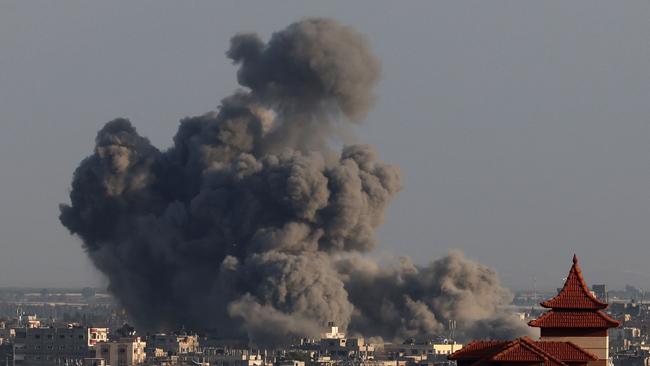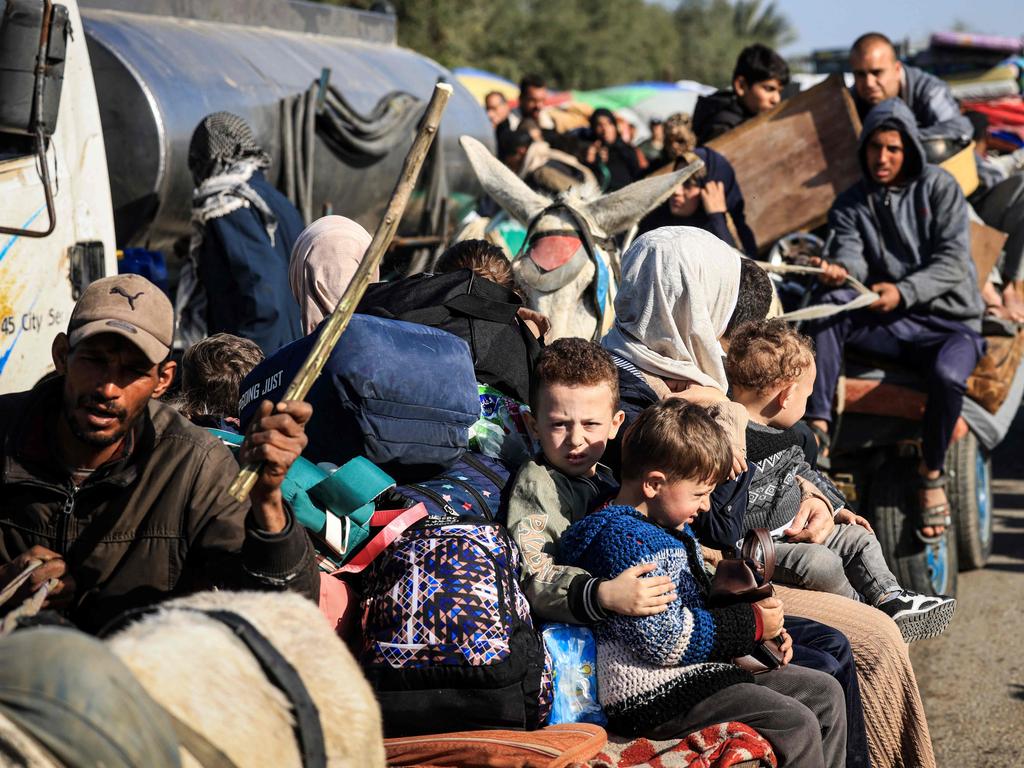Israelis brace for gruelling urban battle as it encircles Khan Younis
Officials say operation is targeting Hamas militants, as Israeli forces encircle Khan Younis in southern Gaza.

The Israeli military said it was pushing into the west of Khan Younis and was engaged in fierce fighting with some of Hamas’s strongest fighters after encircling the southern Gaza city, where the population has swelled by hundreds of thousands of displaced Palestinians.
Israel said Wednesday it was targeting Hamas militants using snipers, tanks and aerial fire and was aiming to destroy complex tunnel networks and infrastructure used by the group. Israeli officials say they believe that inside the city are Hamas’s leadership and Israeli hostages, whom Israeli officials are seeking to free in part through military pressure on Hamas.
The military thrust into Khan Younis reflects a new phase in the war as Israel shifts to urban fighting that is more time consuming and dangerous for its troops. About two dozen Israeli troops were killed in central and southern Gaza on Monday in the deadliest day for the military in Gaza since the war began on Oct. 7, according to the Israeli military.
Earlier in the conflict, Israel relied on airstrikes to hit what it said were militant targets in the northern part of the Gaza Strip, causing what Palestinians say was a high civilian death toll. In Khan Younis, one of the largest cities in the enclave before the war, Israeli troops are pushing into heavily populated areas where many displaced Palestinians are sheltering, including some who were killed in a United Nations facility that was struck on Wednesday, according to a U.N. official.
The large number of civilians could offer Hamas fighters easier concealment and complicate military operations, as many in the international community -- including the U.S. -- pressure Israel to reduce civilian casualties and seek to wrap up the war. More than 200 Palestinians across the enclave were killed in the past 24 hours, health officials there said Wednesday. Casualty figures from Palestinian authorities don’t distinguish between combatants and civilians.
“As you get closer to the heart of the enemy and its resources, its resistance is stronger,” said retired Israeli Col. Gabi Siboni, a senior research fellow at the Jerusalem Institute for Strategy and Security. “Khan Younis is a key Hamas stronghold.”
The Israeli military said that during the operation, weapon stockpiles had been discovered and that three militants who approached Israeli soldiers were killed in precision strikes. The operation into west Khan Younis is set to last several days, the Israeli military said.
“All efforts are aimed at creating intense military pressure, both on the tunnel infrastructure and on the operational command level, out of the understanding that this will be what subdues Sinwar,” said Eyal Pinko, a retired Israeli military officer, referring to Hamas’s leader in Gaza, Yahya Sinwar. Israel has yet to capture or kill Hamas senior leadership in Gaza, a stated war aim.
As fighting has raged in the militant group’s last stronghold, Hamas officials in recent days have told international mediators that they are open to discussing a deal to release some of the Israeli hostages in exchange for a significant pause in fighting. The offer marks a significant shift by Hamas, which for weeks has insisted it would only negotiate on releasing more hostages as part of a comprehensive agreement that would lead to a permanent end to the war. There are 132 hostages remaining in Gaza, including 28 bodies held by Hamas, according to the Israeli Prime Minister’s Office.
While Israel and Hamas have rejected multiple proposals made via Egypt and Qatar following the end of the last cease-fire on Nov. 30, they now largely agree on a framework that includes multiple phases and a potential long-term cease-fire.
The first phase would likely involve the release of about 10 civilian women and children in exchange for a significant pause in fighting and a substantial increase in the flow of aid into Gaza, Egyptian officials said.
The second phase would see Hamas freeing roughly 40 elderly and injured people, as well as Israeli female soldiers, in exchange for the release of an unspecified number of Palestinians in Israeli prisons and an extension of the cease-fire. This would be followed by the release of male soldiers and dead bodies, the officials added.

The U.S., Egypt and Qatar see another hostage deal as the key to bringing a prolonged halt to the fighting, the officials said.
Israeli Prime Minister Benjamin Netanyahu’s office has declined to comment on the framework. Egyptian officials say that while Israeli leaders are publicly taking an uncompromising stance, there are divisions within the Israeli cabinet, with some calling for giving priority to hostages.
Some Hamas officials say talks are continuing but that gaps remain wide. Other Hamas officials are seeking to gain maximum advantage from the captives the militant group holds and only want to trade them for thousands of Palestinian prisoners and a permanent cease-fire.
Israel issued evacuation orders for parts of Khan Younis on Tuesday. The U.N. said the orders covered 4 square kilometers and affected 88,000 residents, in addition to 425,000 internally displaced people staying in shelters and hospitals, including Nasser Hospital, the area’s largest medical facility and one of the few major medical facilities still operating.
“Nasser Hospital has lost most of its staff due to fear of escalating violence, and the remaining staff is struggling to keep the hospital operational,” said Zaher Sahloul, president and cofounder of MedGlobal, a humanitarian nonprofit working at the facility. “There is a mass exodus from Khan Younis to an ever-shrinking area near the Rafah border, leading to massive displacement and overcrowding.”
Residents and medical professionals in and around Khan Younis say heavy gunfire and bombing in the area make it difficult to heed evacuation orders as civilians are caught in the line of fire. Meanwhile, consistent telecommunications disruptions and blackouts hamper humanitarian efforts and restrict the information leaving the enclave.
One of the largest U.N. shelters in Khan Younis was struck on Wednesday for the second time in recent days, with buildings set ablaze and mass casualties, a U.N. official said. The official said two tank rounds hit a building that was sheltering 800 people, killing nine people and injuring more than 70 others.
“The compound is a clearly marked @UN facility & its coordinates were shared with Israeli Authorities as we do for all our facilities. Once again a blatant disregard of basic rules of war,” Philippe Lazzarini, commissioner-general of the U.N. agency that manages Palestinian refugees, said in a post on X. Lazzarini said six displaced people were killed by an earlier strike on Monday.
A U.S. State Department spokesman called the strike at the U.N. facility “incredibly concerning.” “We deplore today’s attack on the U.N.’s Khan Younis [facility],” he said. “The protected nature of U.N. facilities must be respected.” The Israeli military said it determined the U.N. incident was not “a result of an aerial or artillery strike” by its forces, but that it hadn’t made a final assessment. The military said it was also examining the possibility that the strike on the U.N. facility was the result of Hamas fire. “A thorough review of the operations of the forces in the vicinity is under way,” it said.
More than 25,000 people, mainly women and children, have been killed in Gaza since the start of the Israel-Hamas war, according to Palestinian authorities. Israel began its air, ground and sea campaign in Gaza after Hamas militants conducted a cross-border attack on Oct. 7 that killed 1,200 people, mostly civilians, according to Israeli authorities.
“Less than 20 per cent of Gaza’s land — roughly 60 square kilometres — is now refuge to over 1.5 million people,” the International Committee of the Red Cross said. “These people are living in desperate circumstances in the south of the Gaza Strip where the dramatic escalation of the fighting threatens their survival.”
Anat Peled contributed to this article
The Wall Street Journal






To join the conversation, please log in. Don't have an account? Register
Join the conversation, you are commenting as Logout